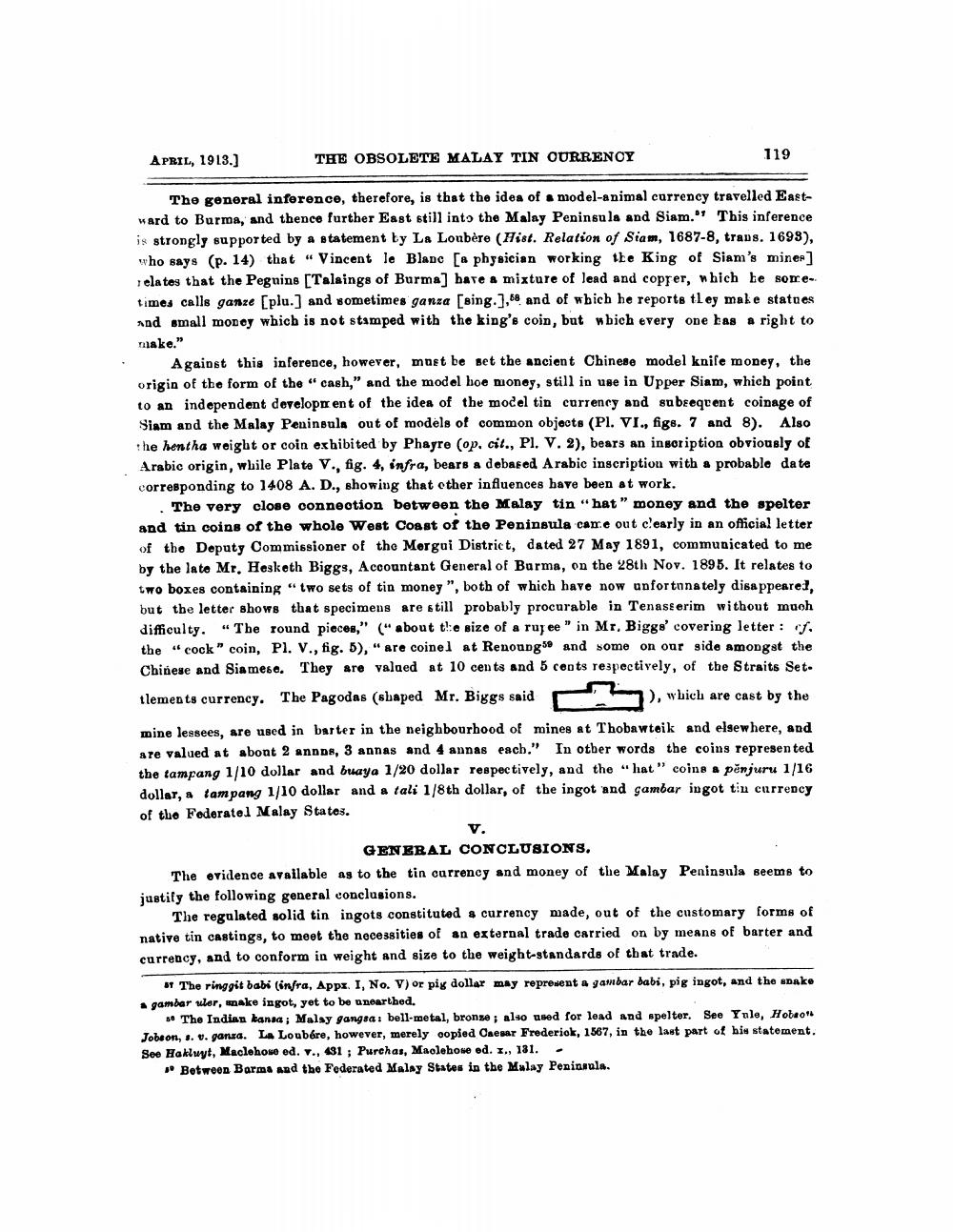________________
APRIL, 1913.)
THE OBSOLETE MALAY TIN QURRENCY
119
The general inference, therefore, is that the idea of a model-animal currency travelled Esstward to Burma, and thence further East still into the Malay Peninsula and Siam." This inference is strongly supported by a statement by La Loubère (Hist. Relation of Siam, 1687-8, traps. 1699), who says (p. 14) that Vincent lo Blanc [a physician working the King of Siam's miner]
elates that the Peguins [Talaings of Burma] bare a mixture of lead and coprer, which be some times calls ganze [plu.] and sometimes ganza (Bing.],68 and of which he reports they make statues and small money which is not stamped with the king's coin, but wbich every one has a right to make."
Against this inference, however, must be set the ancient Chinese model knife money, the origin of the form of the "cash," and the model boe money, still in use in Upper Siam, which point to an independent developer ent of the idea of the model tin currency and subsequent coinage of Siam and the Malay Peninsula out of models of common objects (Pl. VI., figs. 7 and 8). Also the hentha weight or coin exhibited by Phayre (op. cit., Pl. V. 2), bears an insoription obviously of Arabic origin, wbile Plato V., fig. 4, infra, bears a debased Arabic inscription with a probable date corresponding to 1408 A. D., showing that other influences have been at work.
The very close connection between the Malay tin hat" money and the spolter and tin coins of the whole West Coast of the Peninsula came out clearly in an official letter of the Deputy Commissioner of the Morgui District, dated 27 May 1891, communicated to me by the late Mr. Hesketh Biggs, Accountant General of Barma, on the 28th Nov. 1895. It relates to two boxes containing "two sets of tin money ", both of which have now unfortunately disappeared, but the letter shows that specimens are still probably procurable in Tenaseerim without much difficulty. "The round pieces," (" about the size of a ruj ee" in Mr. Biggs' covering letter: cf. the "cock" coin, Pl. V., fig. 5), "are coinel at Renoungs and some on our side amongst the Chinese and Siamese. They are valued at 10 cents and 5 cents respectively, of the Straits Set. tlements currency. The Pagodas (shaped Mr. Biggs said
), which are cast by the mine lessees, are used in barter in the neighbourhood of mines at Thobawtoik and elsewhere, and are valued at abont 2 annos, 3 annas and 4 annas each." In other words the coins represented the tampang 1/10 dollar and buaya 1/20 dollar respectively, and the "hat" coins a penjuru 1/16 dollar, a tam pang 1/10 dollar and a tali 1/8th dollar, of the ingot and gambar ingot tin currency of tho Foderatel Malay States.
GENERAL CONCLUSIONS. The evidence available as to the tin currency and money of the Malay Peninsula seems to justily the following general conclusions.
The regulated solid tin ingots constituted a currency made, out of the customary forms of native tin castings, to meet the necessities of an external trade carried on by means of barter and currency, and to conform in weight and size to the weight-standards of that trade.
- The ringgit babi (infra, App. I, No. V) or pig dollar may represent a gambar babi, pig ingot, and the enako a gambar ler, sake ingot, yet to be unearthed.
5. The Indian kansa; Malay gangsa : bell-metal, bronse; also used for lead and spelter. See Yule, Hobao Jobson, 1. v. ganzo. La Loubére, however, merely copied Caesar Frederick, 1567, in the last part of his statement. See Hakluyt, Maclehow ed. v., 131 ; Purchas, Maolohovo od. ., 131. .
* Between Barma and the Federated Malay States in the Malay Peninsula.




